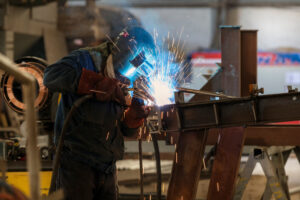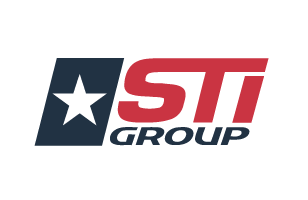One of the most important and versatile industrial welding processes is GMAW welding, also known as gas metal arc welding. This crucial process allows for welding all commercially available alloys and metals and compatibility with all welding positions. Nevertheless, like every other welding process, it has advantages and drawbacks.
What Is GMAW?
Gas metal arc welding (GMAW) utilizes a continuously fed, consumable wire electrode and a power supply to create an electrical arc between the electrode and the workspace, which heats the metals, allowing them to join, making it a versatile arc welding process. A shielding gas is also used to protect the weld from environmental contamination. If an inert gas is used, the welding process is often referred to as “MIG” welding, representing metal inert gas welding, a common term in the industry. If an active gas is used, then the process is often called “MAG” welding for metal active gas. The process may also be referred to by its metal transfer mode. For example, “GMAW-P” is pulsed gas metal arc welding. We’ll examine the metal transfer modes below.
As stated above, GMAW can utilize inert or active gas as the shielding gas and has several metal transfer modes. It typically operates on a constant voltage power supply, direct current system, but it may also utilize alternating current and a range of different amps and volts, as well as different diameter welding wire. Finally, it may be a semi-automatic process where the operator controls the welding gun, or it can be fully automatic, allowing for faster welding speeds and greater productivity. This flexibility means that when properly configured, GMAW can be adapted for various welding applications, handling nearly any industrial metal or alloy, and is suitable for any position welding.
Historical Context of GMAW
Gas Metal Arc Welding (GMAW) has a rich history that dates back to the late 1940s. It was developed in 1948 by the Battelle Memorial Institute. It involved using a smaller diameter electrode and a constant voltage power source created by H. E. Kennedy. GMAW offered a high deposition rate, which was beneficial for welding processes. However, its use was initially limited to non-ferrous materials due to the high cost of inert gases, which prevented cost savings.
GMAW quickly expanded its application to include steels as well, as it allowed for lower welding temperatures and better control during the welding process. The introduction of continuously fed electrode wire in GMAW made the process semi-automatic or automatic, reducing the need for manual electrode manipulation. This innovation significantly increased welding speed and efficiency, making it widely adopted in various industries. This welding process emerged as a more cost-effective alternative to Gas Tungsten Arc Welding (GTAW).
Over time, GMAW has become a popular welding method in industries such as automotive, construction, and general fabrication. It offers advantages such as high welding speeds, excellent weld quality, and versatility in welding different material thicknesses. Advancements in GMAW technology have further improved the process, including developing new shielding gases and wire types tailored for specific applications.
You can explore STI Group’s history of welding and other industrial processes in our Interactive Historical Timeline.
Metal Transfer Modes for GMAW
GMAW may use one of the following metal transfer modes:
Globular – The globular metal transfer mode uses carbon dioxide as its shielding gas, which is advantageous since carbon dioxide is less expensive than argon, the other major shielding gas. The globular mode also has a high deposition rate, allowing for faster weld speeds. However, globular also tends to produce a great deal of heat compared to other modes, often creates irregular or uneven welding surfaces, is prone to spatter, requires thicker workpieces, and must be used on flat or horizontal weld positions. These drawbacks make it one of the least used GMAW variations for industrial welding.
Short-Circuiting – The short-circuiting transfer mode is often known as SCT or short-arc GMAW. In this mode, the molten metal droplets actually bridge the space between the electrode and the weld pool, thus extinguishing the arc. However, almost immediately, the surface tension between the molten bead and the weld pool causes the bead to be pulled off the electrode, and the arc reignites. This process happens about 100 times per second and is not visible to the human eye, causing the arc to appear constant. However, the process does require a slower wire feed rate. It also can be used on thinner pieces of work metal than the globular method; however, it can still only be used on ferrous metals and, when used on thicker metals, may result in insufficient weld penetration and a lack of fusion.
Spray – The spray transfer mode is the original transfer method for GMAW and was developed in the 1940s to allow for the welding of non-ferrous metals such as aluminum. In this transfer mode, the welding electrode is rapidly passed along a stable electric arc to the workspace, resulting in a better weld finish with little or no spatter. This is possible because, at higher currents and voltages, the molten droplets change from globules to smaller droplets, eventually vaporizing steam. However, this requires more heat and a larger weld pool, which typically means that the workpiece must have a thickness of at least a quarter inch or more. The large weld pool also limits the weld positions possible.
Pulsed-Spray – The pulsed-spray transfer mode, often called pulsed GMAW, pulsed MIG, or GMAW-P, is a variation of the spray transfer mode. However, it uses a pulsing current instead of a stable current. This allows one molten metal droplet to fall per pulse. The average current is also lower, thus reducing heat and allowing for a smaller weld pool. The lower heat and smaller weld pool allow for welding on thinner pieces of metal and in all weld positions. This makes GMAW-P one of the most useful and popular industrial welding processes. We’ll go into more detail about it in a subsequent article.
Practical Applications of GMAW Welding
GMAW is widely used across various industries due to its versatility and adaptability. In the construction industry, it’s used for building structures and infrastructure thanks to its ability to create strong, durable welds. In manufacturing, GMAW is essential for fabricating various products, from machinery to consumer goods.
The automotive industry relies heavily on GMAW in vehicle production and car racing. It’s used for everything from assembling car bodies to repairing frames. GMAW is used to fabricate and repair race car components in motorsports due to its speed and strength.
Moreover, GMAW has found applications in more specialized areas like underwater welding, which is used for repairing ships, offshore oil platforms, and pipelines. Its ability to work in diverse environments makes it a valuable tool in these challenging conditions.
Gases Used in GMAW Welding
GMAW gas is required in GMAW welding to protect the weld pool from contaminants in the air. The most common types of gases used during the process are argon and helium, both inert gases. This means they will not undergo chemical reactions under the welding process conditions.
However, active gases such as carbon dioxide can also be used. This is called metal-active gas (MAG) welding. Some welders combine active and inert gases to achieve specific welding characteristics. Each type of gas or gas mixture provides a unique penetration profile and affects the properties of the weld.
Power Sources and Polarity in GMAW Welding
GMAW welding typically uses a constant voltage power source. This type of power source maintains a steady voltage during the welding process, which helps to produce stable welding conditions. The power source also features a self-correcting arc length feature, which adjusts the arc length to maintain a consistent weld bead.
Regarding polarity, GMAW welding processes operate with reverse polarity, where the wire electrode is positive. This is because more heat is generated at the positive electrode, which helps reduce the chance of defects from a lack of fusion.
Equipment and Tools Used in GMAW Welding

Various GMAW equipment is required to ensure a successful GMAW welding process.
- GMAW Welder: This is the primary tool used for GMAW. It provides the power source and controls for the welding process.
- Welding Magnets: These are used to hold pieces of metal in place during the welding process.
- Angle Grinder: This tool prepares the metal before welding and finishes the weld afterward.
- Chop Saw: This is used to cut metal to the desired size before welding.
- Soapstone: This is used for marking on metal, which is essential for accurate welding.
- Pliers: These handle hot metal and adjust the welding setup.
- Clamps: Clamps are used to hold the workpieces in place during welding securely.
- Chipping Hammer: This tool removes slag from the weld bead.
- Band Saw: This is used to cut metal to the desired size before welding.
- Safety Equipment: Safety is paramount in welding. Auto-darkening helmets protect the eyes from the intense light produced by the arc. Gloves protect the hands from heat and sparks, and protective clothing shields the body from heat and ultraviolet radiation. For comprehensive safety guidelines during welding processes, refer to the Occupational Safety and Health Administration.
The Advantages of GMAW Welding
- Fully automatic operation, resulting in higher productivity.
- Suitable for welding all metals and alloys.
- It can be used in all weld positions.
- Produces lower levels of fumes compared to FCAW or SMAW.
- Requires less operator skill compared to SMAW.
- Utilizes a continuously-fed electrode, minimizing defects as no restarts are needed.
- Does not use slag, reducing post-weld clean-up.
- Provides good weld penetration, allowing for strong joints with smaller weld sizes.
The Disadvantages of GMAW Welding
- Requires relatively complicated and expensive equipment compared to other welding processes.
- Less portable than SMAW.
- It cannot be used in areas with drafts or outdoors as the shielding gas would dissipate.
- Less suited to smaller, constricted spaces due to the welding torch design and the need for close gas shielding.
- Requires very clean and rust-free base metals.
- Has lower deposition rates than FCAW when welding out of position.
- Requires careful adjustment of process parameters to avoid fusion defects, especially on thicker base metals.
STI Group is strongly committed to welding and quality and offers reliable, carefully configured GMAW ideal for various industrial welding requirements. Learn more about our commitment to quality in our Pipe Fabrication Services. We will always strive to produce nothing but consistent, strong, defect-free welds, and GMAW is an excellent tool to do just that thanks to its flexibility and range of applications.
Additional Resources
- American Welding Society (AWS): For more detailed information on GMAW and other welding processes, visit the American Welding Society.
- National Institute for Occupational Safety and Health (NIOSH): Additional resources on welding safety can be found at the National Institute for Occupational Safety and Health.
- Lincoln Electric: For a wide range of GMAW welding products and educational resources, visit Lincoln Electric.
- Miller Welds: Another excellent resource for welding equipment and educational materials is Miller Welds.
- Welding Journal: For more industry insights and articles on welding, check out the Welding Journal

